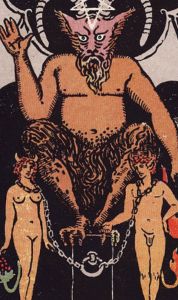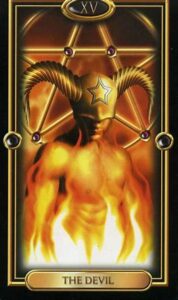The Devil Tarot Card in Meaning, Love, Wealth, and Beyond. In the intricate tapestry of tarot symbolism, few cards evoke as much intrigue and apprehension as the Devil card. Often associated with fear, temptation, and bondage, its imagery carries a weighty significance that transcends mere superstition. In this comprehensive article, we delve into the profound symbolism and impact of the Devil tarot card on meaning, love, wealth, and beyond. Additionally, we explore its dynamic combinations with other cards, offering insights into the complexities of human experience and the journey towards liberation.
The Devil Tarot Card:
“The Devil” tarot card is one of the most complex and intriguing cards in the Tarot deck, often evoking strong emotions and interpretations. Here’s a detailed exploration of the key features and symbolism associated with “The Devil” tarot card:
1. Visual Symbolism:
- The Devil is typically depicted as a horned figure, often resembling a satyr or goat, standing on a pedestal or throne.
- The figure is usually depicted as androgynous or possessing both masculine and feminine characteristics, representing the duality and polarity inherent in human nature.
- The Devil is often portrayed with bat-like wings, a symbol of darkness and temptation, and chains or ropes binding two figures, symbolizing bondage and enslavement.
- In some depictions, there may be inverted pentagrams or other occult symbols, emphasizing the card’s association with temptation, materialism, and earthly desires.
2. Meaning and Interpretation:
- The Devil represents the shadow aspect of human nature, as well as the forces of temptation, bondage, and illusion.
- It symbolizes the aspects of ourselves or situations that keep us trapped in patterns of behavior or thought, preventing us from experiencing true freedom and enlightenment.
- The Devil often appears in readings when individuals are feeling trapped, enslaved, or caught up in unhealthy attachments, addictions, or obsessions.
- It can indicate a need to confront and overcome the darker aspects of ourselves, such as fear, greed, or ego, in order to break free from self-imposed limitations.
- The Devil may also represent external influences or situations that exert control or manipulation over us, such as toxic relationships, societal norms, or oppressive systems.
3. Key Themes of the devil tarot card:
4. Interpretation in Readings:
- In readings, the Devil may indicate a need to confront and release unhealthy attachments, addictions, or patterns of behavior that are holding us back.
- It can suggest a warning against giving in to temptation or succumbing to negative influences that lead us away from our higher purpose.
- The Devil may also indicate the need to examine power dynamics in relationships or situations and to assert our autonomy and boundaries.
- Ultimately, the Devil challenges us to confront our shadows, embrace our complexity, and take responsibility for our actions in order to achieve true freedom and self-mastery.
Overall, the Devil tarot card serves as a powerful reminder of the importance of confronting our fears, illusions, and attachments in order to achieve greater self-awareness, empowerment, and liberation. It encourages us to embrace the complexity of human nature and to strive for authenticity, integrity, and spiritual growth.
The Devil card reminds us that true liberation comes from within, through the process of facing our fears and embracing our shadows. It encourages us to confront the aspects of ourselves that we may have been avoiding or denying, knowing that only by acknowledging and integrating them can we experience true freedom and authenticity.
The devil tarot card and Impact on Love:
In matters of the heart, the Devil card can signify toxic or unhealthy relationships characterized by codependency, manipulation, or control. It may indicate a need to examine the dynamics of our partnerships and confront any patterns of behavior that contribute to imbalance or dysfunction. While this may initially bring feelings of discomfort or resistance, it offers an opportunity for growth and transformation.
For those in committed relationships, the Devil card invites honest communication and introspection. It encourages partners to examine the underlying power dynamics and address any issues of dependency or possessiveness. While the process may be challenging, it can ultimately lead to greater intimacy, trust, and freedom within the relationship.
The devil Tarot Card and impact on Wealth:
In matters of wealth and abundance, the Devil card signifies the pitfalls of materialism and attachment to worldly possessions. It may indicate a tendency to prioritize material gain at the expense of spiritual or emotional fulfillment. When the Devil card appears in a tarot reading related to wealth, it serves as a warning to examine our values and priorities and consider whether our pursuit of wealth is truly serving our highest good.
The Devil card reminds us that true abundance is not measured by material possessions alone but by the richness of our inner lives and the depth of our connections with others. It encourages us to release attachments to external validation and embrace a more holistic approach to wealth that honors the interconnectedness of all things.


The combination of the devil and other tarot card:
Combining “The Devil” tarot card with another card in a reading can create a complex and nuanced interpretation, blending the energies and symbolism of both cards. Here’s an in-depth exploration of several combinations:
- The Devil and The Lovers:
- This combination represents the struggle between passion and temptation in relationships. The Devil symbolizes unhealthy attachments, addictive behaviors, or codependency that may be causing discord or imbalance in the relationship. The Lovers card signifies a deep connection and choice between two paths, suggesting that the individuals must confront their desires and make choices based on true love rather than mere attraction or lust. It encourages honest communication, self-awareness, and the courage to break free from toxic patterns in order to cultivate a healthier and more fulfilling relationship.
- The Devil and The Tower:
- This pairing indicates a crisis or upheaval resulting from the revelation of hidden truths or the breakdown of illusions. The Devil represents the bondage of false beliefs, addictions, or materialistic desires that have kept the individual trapped in a state of ignorance or denial. The Tower signifies the sudden and dramatic collapse of these illusions, forcing the individual to confront their shadow aspects and break free from self-imposed limitations. Together, they suggest a profound awakening or liberation from destructive patterns, although the process may be tumultuous and challenging. It encourages surrendering to the transformative power of change and embracing the opportunity for growth and renewal that follows upheaval.
- The Devil and The High Priestess:
- This combination highlights the tension between the material and spiritual realms. The Devil represents worldly desires, temptations, and distractions that may be obscuring deeper spiritual truths or intuition. The High Priestess symbolizes intuition, wisdom, and inner knowing, suggesting that the individual must look beyond surface appearances and tap into their inner wisdom to discern truth from illusion. It encourages tuning into intuition, introspection, and spiritual practices to navigate through the complexities of the human experience and find balance between the material and spiritual aspects of life.
- The Devil and The Fool:
- This pairing represents the journey of self-discovery and liberation from societal conditioning or expectations. The Devil symbolizes the constraints of societal norms, peer pressure, or conformity that may be holding the individual back from embracing their true identity or pursuing their authentic path. The Fool signifies innocence, spontaneity, and the courage to embark on a new journey of self-discovery and personal freedom. Together, they suggest a need to break free from external expectations, embrace uncertainty, and trust in the journey of self-discovery, even if it means stepping into the unknown. It encourages embracing authenticity, individuality, and the freedom to chart one’s own course in life.
- The Devil and The Star:
- This combination represents hope and healing emerging from a period of darkness or turmoil. The Devil symbolizes the shadows, fears, and illusions that have kept the individual trapped in a state of bondage or despair. The Star signifies inspiration, guidance, and the promise of renewal, suggesting that even in the midst of adversity, there is a glimmer of hope and light to guide the way forward. Together, they suggest a journey of healing and transformation, where the individual confronts their inner demons, releases old wounds, and embraces a sense of hope and optimism for the future. It encourages trusting in the process of healing and allowing oneself to be guided by the light of inner wisdom and divine guidance.
In each of these combinations, “The Devil” tarot card challenges the individual to confront their fears, desires, and attachments in order to achieve greater self-awareness, liberation, and spiritual growth. It encourages embracing authenticity, breaking free from self-imposed limitations, and trusting in the transformative power of change.
Conclusion:
In the intricate tapestry of tarot symbolism, the Devil card serves as a powerful reminder of the illusions and attachments that bind us and the liberation that comes from confronting our shadows. Its impact on meaning, love, wealth, and beyond is profound, inviting us to break free from self-imposed limitations and embrace our true power and potential. May we heed the wisdom of the Devil card and embark on the journey towards liberation with courage, clarity, and an open heart.

I’m Erin. I’m an artist, designer, author and entrepreneur. I’m also a mom, feminist, volunteer and activist. Some of things that light me up are textiles, theology, alien theory, comic book art, live music, travel and learning. I am constantly evolving as a creative and a human.
